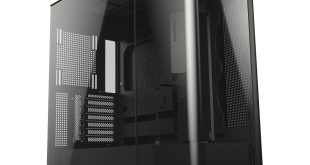Despite widespread criticism with the first batch of Phantom 820 reviews and user opinions, NZXT has continued to use flexible plastic drive trays. There's no way we would feel safe shipping a system with drives installed in the plastic trays. NZXT really needs to design and implement a sturdier mounting mechanism.
Securing a 3.5″ drive is a tool-less procedure, while 2.5″ drives require four screws irrelevant of whether they are installed in a 3.5″ tray or a native 2.5″ holder.
A 3.5″ drive helps to give the flexible trays the rigidity required to remain positioned inside the bay provided the system isn't moved about. Using a 2.5″ drive, the tray isn't particularly secure when inside the bay.
Thanks to its large internal space and excellent cable management system, the NZXT Phantom 630 is a very easy case to work with. Our mid-range ATX build is dwarfed by the sizeable interior, giving a clear indication that multi-VGA configurations will be easily housed by the 630.
NZXT's grommet positioning is faultless. Cables exiting and entering the motherboard's ‘business area' can be routed through any of the three adjacent grommets. Front panel cables have a grommet to themselves which is located just beneath the lower-edge of an ATX motherboard.
Thanks to the 28 to 35 millimetres of clearance behind the Phantom 630's motherboard tray, cable management doesn't have to be a time-consuming or meticulous procedure. We simply routed the cables to their intended location, taking care not to make too many overlaps, and compressed them against the motherboard tray when attaching the side panel.
Even with the additional PCI-E cables brought about by multi-VGA configurations, the rear area still has plenty of room to house the mess without requiring a careful routing plan.
Despite the exclusion of a specific grommet and hole, routing the 8-pin cable behind the motherboard tray was still a possibility. A specific grommet would still be preferable because a fair amount of force was required to push the cable through the gap and a greater length is also important.
With a maximum clearance of just over 200mm, the Phantom 630 makes large CPU coolers such as the Thermaltake Frio look small. There wouldn't be any problems fitting a high-end CPU cooler, such as Phanteks' PH-TC14PE, in the Phantom 630, along with a thick roof-mounted 360mm radiator for a GPU-only loop.
Our small Sapphire HD 7850 Dual-X graphics card is easily housed in the 630's 320mm of expansion slot clearance.
Mounting Seasonic's high-quality Platinum-1000 in the NZXT Phantom 630 proved a close call. The modular cables run directly above the case's bottom drive rail, but aren't quite blocked. A larger power supply may require the drive rail to be removed.
Around 37mm of clearance behind the 3.5″ drive bays makes connecting and routing SATA power and data cables a hassle-free procedure.
Connecting cables to the specific 2.5″ mount won't be an issue, thanks to the Phantom 630's healthy clearance behind the motherboard tray.
A 5.25″ optical drive is securely held in place by the Phantom 630's sturdy tool-less mounting mechanism.
As has been commonplace with NZXT's recent up-market cases, the Phantom 630 features an LED on the rear IO panel that provides assistance when searching for cables and ports.
It would have been nice if NZXT had designed the window to show off more of the graphics card area, but we prefer the 200mm intake fan over increased visibility.
It's now when the LED lighting system that is featured on the Phantom 820 would be welcomed. The window is good, but it feels somewhat wasted when the case's internal area is dark and difficult to see.
NZXT's decision to omit the LED system was probably the best one; lighting won't appeal to all and it increases the chassis cost which can have big implications on the Phantom 630's viability to system builders such as PCSpecialist and DinoPC. Scan sells the NZXT LED lighting strip for just over £10, meaning that users can fit their own lighting without too large a purchase required.
 KitGuru KitGuru.net – Tech News | Hardware News | Hardware Reviews | IOS | Mobile | Gaming | Graphics Cards
KitGuru KitGuru.net – Tech News | Hardware News | Hardware Reviews | IOS | Mobile | Gaming | Graphics Cards








![HDDs]](http://www.kitguru.net/wp-content/uploads/2013/06/HDDs-300x225.jpg)




